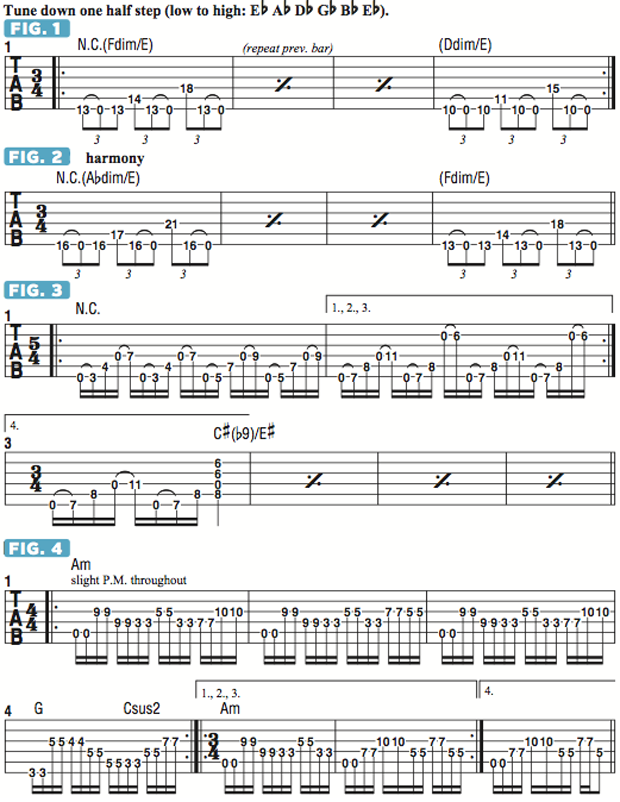Thrash Course with Dave Davidson: Exploiting Odd-Time Meters, and How I Play “Madness Opus” and “Witch Trials”

A favorite compositional technique of mine in the songs I record and perform with Revocation is to incorporate the use of odd and shifting meters in the writing of primary riffs.
Another cool approach I often take is to combine straight 4/4 time with odd meters to create some interesting and unique amalgamations.
For the song “Madness Opus,” I set the main figure, which is phrased in a rhythm of steady eighth-note triplets, in 3/4 meter, as shown in FIGURE 1. If we think of the initial note, F, as the tonic, or root, the chord that is alluded to is Fm-maj7b5.
The use of pull-offs on the sixth string is essential to the proper articulation and sound of this riff. The one-bar pattern is played three times, after which I transpose it down a step and a half, or a minor third, so that the initial note is D, at which point the chordal allusion is Dm-maj7b5. Regarding the pick-hand, I pretty much stick with alternate (down-up) picking throughout, starting with two downstrokes on the low F notes and then switch to alternate picking for the notes that are consecutively picked.
On the recording, after this phrase cycles through a few times, I bring in an overdubbed guitar part, illustrated in FIGURE 2, that plays the same riff but transposed up a minor third, or a step and a half. This results in a harmonized line known as a parallel harmony, for which every fretted note is a minor third above the melodic line.
Given that the line itself is very dissonant sounding, the harmony of a minor third above it pushes the musical effect even further into “alien” territory. I love to harmonize riffs using different intervallic distances like this, and playing a line a minor third above always works well.
Another great example of the incorporation of odd meter is the primary riff to “Witch Trials,” shown in FIGURE 3. The majority of this phrase is played in 5/4 time, after which I shift very unexpectedly to 3/4. The figure is played in straight 16th notes but phrased in five-note groups, so that the initial note, the open low E, steadily shifts one 16th note later in the bar through each five-note group. The very nature of the phrasing of the melody creates the 5/4 meter in that it takes five beats of the pattern before the open low E will once again fall squarely on beat one. At the end of the phrase, I play a very atonal chord that my be analyzed as C#(b9)/E#.
Get The Pick Newsletter
All the latest guitar news, interviews, lessons, reviews, deals and more, direct to your inbox!
For our final example, also from “Witch Trials,” (see FIGURE 4), I begin in 4/4 but then wrap up the idea in 3/4. I think of the riff as being in A natural minor (A B C D E F G) with pairs of intervals placed against the low A pedal tone. I begin with a pair of notes—E and B, a fourth apart— followed by F and C, a fifth apart, then by A and F, an augmented (sharped) fifth apart. When I shift to 3/4, I simply bring the open low A pedal tone back in after playing the phrase across three quarter notes.











